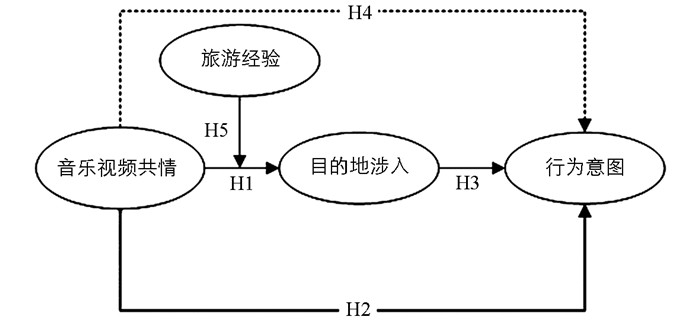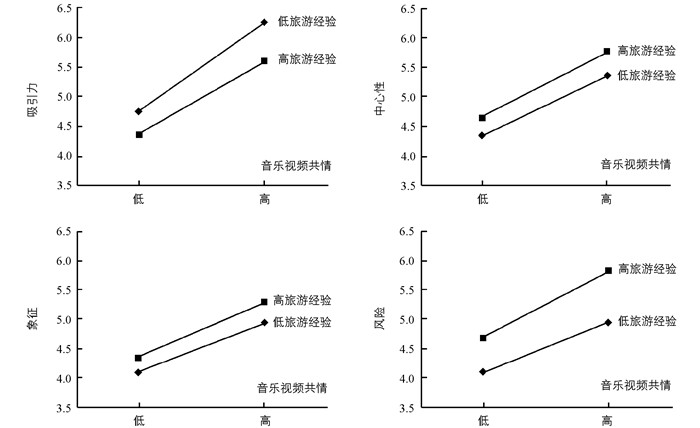-
2020年初爆发的新冠肺炎疫情,对我国乃至世界经济造成了巨大的冲击,尤其是极度依赖流动性的旅游业,在此次公共卫生安全事件中更是遭受重创.根据中国旅游研究院报告预测,受新冠肺炎疫情影响,2020年第一季度及全年国内旅游人次将分别负增长56%和15.5%,全年同比减少9.32亿人次;国内旅游收入将分别负增长69%和20.6%,全年减收1.18万亿元[1],因此我国旅游业正面临着巨大“寒冬”. 2019年统计数据显示,全年国内游客60.1亿人次,国内旅游收入57 251亿元,占全国国民总收入的5.79%,旅游业已经成为带动国内经济发展、解决国民就业的核心产业之一[2].在疫情背景下,如何积极有效地促进旅游业恢复活力,全方位激发公众出游愿意,重振旅游业对经济发展的带动作用,是当前亟需探讨的问题.
随着国内疫情防控进入常态化阶段,疫情带给社会民众的心理影响值得关注[3].疫情期间,为了缓解社会紧张情绪,传播抗疫正能量,官方媒体和民间组织创作了大量展现地方精神的文艺作品,引发了强烈的社会共情和舆论关注.比如点击率极高的《武汉伢》 《明天依然最美》等音乐视频作品,为人们展示了疫情下武汉的城市面貌和生活状态,唤起了人们的共情和向往. “相约武汉,共赏樱花” “待春暖花开,同游黄鹤楼,共品热干面”等网络舆论层出不穷,为疫情过后武汉旅游业的恢复营造了良好的社会氛围.这种基于抗疫音乐视频共情的目的地涉入现象,为疫情背景下目的地营销提供了新的切入点.抗疫音乐视频能够唤起公众对疫情受灾区的情感共鸣,进而激发公众对目的地的兴趣和向往,为疫情背景下的出游决策奠定情感基础.
基于此,本研究以新冠肺炎疫情期间网络点击率最高的《武汉伢》音乐视频作为研究素材,探讨了基于抗疫音乐视频共情的目的地涉入对潜在旅游者行为意图的影响,以期为疫情受灾区旅游业恢复和目的地营销提供参考.
全文HTML
-
涉入理论最早可追溯到1947年心理学者Sherif等[4]提出的“自我涉入”(ego-involvement)概念和社会判断理论,认为自我涉入是一种态度结构,包括什么是重要的、有意义的和相关的,常被个体用来对自我和他人进行判断,并影响行为决策[5-6]. 20世纪60年代中期,Krugman[7]提出了“消费涉入”(consumer involvement)的概念,并在消费行为领域得到广泛关注. 1988年,Selin等[8]最早将自我涉入理论引入休闲和旅游研究领域,认为涉入是存在于个体与休闲活动之间的识别状态,具有特定的认知和情感意义,在休闲旅游决策中具有重要影响. 1990年,Havitz和Dimanche提出游憩和游客涉入(tourist involvement)的概念,指由游憩活动、旅游目的地及其相关产品所引发的个体的动机、激活或兴趣的心理状态[9]. 1993年,Havitz等[10]提出了休闲涉入(leisure involvement),认为休闲涉入由特定的刺激或情境激发,并具有驱动性.之后,涉入在旅游情境中的研究不断涌现,学者们开始关注游客涉入的测量并探讨涉入与其他旅游要素之间的关系,包括旅游活动分类[11]、旅游行为意图[12]、家庭度假决策[13]、旅游对社区的影响[14]、游客忠诚度[15]等.
从以往研究来看,涉入理论被有效地应用在休闲和旅游产品中[16],但是对于旅游目的地这一重要对象的研究却没有引起足够关注.目的地涉入是个体对目的地意义赋予、情感建立的过程,会影响个体的态度形成与后续决策[17]. 1990年,Havitz等[9]提出了目的地涉入的测量维度,并强调了研究目的地涉入的重要性. Hu[18]从吸引力、体验风险和财务风险3个维度对目的地涉入进行了测量,研究了在满意度的中介作用下目的地涉入对游客重游意愿的影响;Carneiro等[19]从兴趣/愉悦感和象征两个维度,研究了目的地涉入对游客旅游信息搜索的影响;Gursoy等[20]对涉入与游客度假决策、目的地选择之间的关系进行了探讨.总体来看,目的地涉入更加侧重游客和特定目的地之间的情感联系,并且会对游客后续的决策行为产生影响[17],但其作用机制有待进一步研究.
基于以上文献综述,本研究中目的地涉入是指,在新冠疫情背景下,由目的地相关信息所引发的个体的动机、激活或兴趣的心理状态,并对疫情背景下潜在旅游者的旅游决策具有促进作用.现阶段,通过探讨目的地涉入的作用机制,能够为疫情背景下旅游目的地营销提供借鉴.
-
音乐是情感体验的产物,源自人的内心活动,反过来又对人的态度行为产生影响.在有效事件或视觉信息的刺激下,音乐能够唤起更强烈的共鸣[21].近年来,基于视频的共情研究逐渐兴起[22],尤其是具有视觉和听觉双重刺激的音乐视频,更能够引发共情. 1909年,Titchener将希腊语“Empatheia”翻译为英语“Empathy”得到“共情”的概念[23].众多学科将共情纳入研究并进行了广泛的讨论[24],共情被解读为对他人观点、情感和体验的理解[25-26]. Moriguchi等[27]认为共情是理解和分享他人感受,并对他人的处境做出适当反应的能力[28].目前,共情在旅游领域的研究并不突出[29],主要集中在黑色旅游[30]、原真性[31]等方面.
共情的变化特征取决于特定的情境和过程[32].共情能够引发人们的关注,并通过与事物的交互形成涉入. Su[33]研究了零售商店中客户情感联系对非常规事件的预期反应,结果表明较高的共情能力会提升自我涉入意愿. Adongo等[34]研究表明,基于不同价值观的共情会影响人们对于可持续旅游发展的态度. Bian等[35]认为,观看他人旅行视频能够增加个体的涉入.在新冠疫情背景下,以疫情为题材创作的音乐视频能够激发共情,促进目的地涉入.由此,得到假设1.
H1:抗疫音乐视频共情对目的地涉入具有正向作用.
在心理学领域,大量研究表明共情与亲社会行为有紧密联系,它能够激发亲社会动机[36-37].同样,在旅游地理学的研究中,共情与行为意图之间具有一定的作用关系.李文明等[38]研究表明自然共情对亲环境行为具有显著的正向作用. Pera等[39]研究表明较低的社会距离会激发共情,从而降低游客负面评论的行为意愿. Akgün等[23]研究表明,旅行记事引起的共情对读者的出游意愿具有显著的积极影响.可见,共情能够对行为意图产生作用.由此,得到假设2.
H2:抗疫音乐视频共情对行为意图具有正向作用.
-
在消费行为领域,研究证实了涉入与信息的关注和收集、产品的重复购买等都有正向作用关系[40].在旅游领域,行为意图反映了个体对实现出游行为所愿意付出的努力[41].涉入对游客的行为意图具有重要影响[17].研究发现,游客涉入对目的地出游意愿的影响是基于涉入和原始行为动机之间的关联[42]. Baloglu[43]认为通过特定信息刺激、心理因素和意象感知的关联,涉入能够对游客的行为意图进行预测. Iwasaki等[44]发现休闲涉入、心理承诺、行为忠诚度之间存在显著正向影响. Cevdet等[45]以伊斯坦布尔文化旅游为研究对象,发现涉入通过体验质量和满意度影响推荐意向.可见,涉入作为一种具有驱动性的兴趣状态,对旅游行为意图具有积极影响.由此,得到假设3.
H3:目的地涉入对行为意图具有正向作用.
在消费领域研究中,涉入是影响态度和行为的重要中介变量[46]. Inoue等[47]研究表明,由中心性、愉悦感和象征3个维度构成的涉入,在消费者感知的企业社会责任和忠诚度之间具有中介作用.在旅游研究中,涉入同样具有中介作用.张宏梅等[48]通过研究发现,游客涉入对旅游动机和游客满意度的关系具有中介作用. Hwang等[49]研究发现,地方依恋通过游客涉入对解说系统游客满意度产生间接影响. Bian等[35]指出,用户在使用社交媒体来计划旅行或观看他人旅行视频时,随着涉入程度的不断提高,出游意愿有所增加.在新冠疫情背景下,抗疫音乐视频共情能够促进目的地涉入的形成,从而激发出游行为意图.由此,得到假设4.
H4:目的地涉入在抗疫音乐视频共情与行为意图之间具有中介作用.
-
特定目的地旅游经验是指旅游者经过特定目的地的旅游活动后,将其获取的信息与知识进行积累与内化,形成认知该目的地的能力,这与旅游者去过该目的地的次数有关[50].旅游经验在旅游研究中是一个重要变量,具有特定目的地旅游经验的游客会有更强的目的地熟悉感和承诺感[51].王阿敏等[52]研究发现,经验丰富的旅游者对目的地的情感体验更积极正面,其重游意愿和推荐意愿更强烈.苏丽雅[50]认为,旅游经验丰富的游客具有较高的自我效能水平,充分相信自己能从旅游活动中获得愉悦感. Gao等[53]研究发现,旅游经验能够有效调节权利差距对酒店在线评论的负面作用. Ragb等[51]研究表明,旅游经验在目的地情感意象与忠诚度之间具有显著的调节作用.在新冠疫情背景下,特定目的地旅游经验会影响抗疫音乐视频共情与目的地涉入之间的关系,由此,得到假设5.
H5:旅游经验在抗疫音乐视频共情与目的地涉入之间具有调节作用.
综合上述文献回顾和研究假设,本研究的概念模型如图 1所示.
1.1. 涉入理论
1.2. 音乐视频共情的作用
1.3. 旅游目的地涉入对行为意图的作用
1.4. 旅游经验的调节作用
-
本研究以《武汉伢》音乐视频引发的共情作为研究起点.这首抗疫歌曲创作于新冠疫情初期,由17位武汉文艺工作者演唱,音乐视频通过中央电视台剪辑播出,呈现了疫情下武汉的城市面貌和街头景象,旋律悠扬动听,歌词娓娓道来[54],传递着歌手对故乡的挂念和热爱,唤起听众强烈的社会共情.
问卷设计主要借鉴现有的成熟量表作为测量工具,题项采用Likert 7点计分法测量.对于涉入的测量,以Zaichkowsky[55]所提出的个人涉入量表(Personal Involvement Inventory,PII)和Laurent等[56]编制的消费涉入量表(Consumer Involvement Profile,CIP)为代表.在此基础上,众多学者基于CIP量表对不同休闲游憩活动的涉入进行测量.本研究在借鉴Kim等[57]和Kyle等[58]学者研究的基础上,选取吸引力(attraction)、中心性(centrality)、象征(sign)、风险(risk)4个维度进行测量.其中,吸引力指潜在旅游者将疫情受灾区作为旅游目的地的兴趣程度[59];中心性指前往疫情受灾区旅游在个体生活中的重要程度[60];象征指个体通过前往疫情受灾区旅游向他人传达的自我形象;风险的测量为了和其他维度方向保持一致,对题项描述进行了正向引导,表示疫情背景下个体不受风险影响而进行旅游决策的意愿.在疫情背景下,通过对目的地涉入4个维度的测量,能够反映出潜在旅游者对在疫情后前往疫情受灾区旅游的心理判断.
对于共情的测量,主要借鉴Davis[61]的量表,并结合抗疫MV讲述的内容和表达的情感,通过“了解抗疫故事” “充满挂念和关心” “武汉需要关爱” “和武汉在一起”4个问题来测量参与者观看MV后产生的共情.对于行为意图的测量,包括疫后出游意愿、疫后与他人谈论/推荐意愿、疫后出行优先选择意愿[62]3个方面设计题项.对于旅游经验的测量,主要参考了Hong等[63]与Gao等[53]的方法,直接询问参与者去过目的地的旅游次数,并认为曾在武汉常住的人具有更丰富的旅游经验.此外,还设计了性别、年龄、学历、收入等基本的人口统计学特征题项.
在网络问卷发放中,首先设计观看《武汉伢》音乐视频至少1分30秒以上,然后进入后续的题目作答;主要对参与者的音乐视频共情、目的地涉入、行为意图和旅游经验进行测量,由此来探讨基于抗疫音乐视频共情的目的地涉入对行为意图的影响.
-
初试问卷采用网络问卷形式,共计回收111份问卷,调研对象排除了目前常住武汉或武汉籍贯的人,有效问卷107份,有效回收率为96.4%.使用SPSS 22.0对初试问卷进行问卷信度检验.信度检验结果表明音乐视频共情、吸引力、中心性、象征、风险、行为意图等6个维度的Cronbach's α系数分别是:0.781,0.848,0.808,0.849,0.759,0.872,信度得分均大于0.7,说明该问卷信度良好.接着对问卷数据进行探索性因子分析,顺利抽取出音乐视频共情、吸引力、中心性、象征、风险、行为意图 6个因子,KMO值为0.792,共解释了数据中70.32%的变异.根据公因子提取的结果,对音乐视频共情中“MV让我了解武汉的抗疫故事”题项描述修改为“MV让我对武汉的经历感同身受”.研究以此为基础形成正式问卷.
-
正式调研时间为2020年3月23-31日.共计回收网络问卷1 184份,剔除了填写时间在2 min以下的问卷,剔除明显大量选择相同选项的问卷,有效问卷945份,有效回收率为79.81%.在样本数据中,性别比例基本均衡,男性占47.62%,女性占52.38%;年龄以中青年为主,18岁以下占4.66%,18~25岁占26.03%,26~30岁占32.70%,31~40岁占23.60%,41~50岁占11.11%,51~60岁占1.69%,60岁以上占0.21%;文化程度以大专以上为主,高中及以下占7.51%,大专占25.40%,本科占39.79%,硕士及以上占27.30%;月收入分布较为均衡,2 000元以下占22.54%,2 000~5 000元占25.50%,5 000~10 000元占31.53%,10 000~20 000元占15.98%,20 000元以上占4.44%;没有武汉旅游经验占52.59%,旅游经验1~3次占30.79%,旅游经验4次及以上占7.30%,具有武汉常住经历占9.31%.总体来看样本数据适合本研究.
运用SPSS 22.0软件对问卷进行信度检验.通过分析可得,音乐视频共情、吸引力、中心性、象征、风险、行为意图的Cronbach's α系数分别为0.923,0.948,0.941,0.930,0.956和0.908,整体问卷的Cronbach's α系数达到0.948,大于0.8的标准,说明问卷题项内部一致性较好.
2.1. 研究设计
2.2. 问卷初试优化
2.3. 正式数据收集
-
采用探索性因子分析,以主成分分析法提取因子,以方差最大正交旋转获取因子载荷,检验总体量表的结构效度[64].结果显示,本研究的问卷KMO值达到了0.929,Bartlett检验有统计学意义,适合进行因子分析.经过因子分析,剔除了“武汉是一座值得一去的英雄城市” “疫情后,我会优先安排去武汉旅游的时间” “疫情后选择去武汉旅游,是一种表达自我的方式”等3个因子载荷较低的题项,最后得到由23个题项测量的6个因子,即音乐视频共情、吸引力、中心性、象征、风险、行为意图,剩余题项的因子载荷均大于0.6,因子的特征根均大于1,累积解释方差达85.527%,表明量表具有理想的结构效度.探索性因子分析结果如表 1所示.
-
为了进一步检验量表与测量潜变量的从属关系,利用AMOS 24.0软件进行验证性因子分析,包括对测量模型的拟合优度、信度和效度进行检验.分析结果显示,χ 2 /df =2.883,小于3;RMSEA=0.049,小于0.05;GFI=0.946,AGFI=0.928,IFI=0.982,TLI=0.978,CFI=0.981,5个指标均大于0.9.这表明测量模型与样本数据拟合良好[65].
潜变量量表信度可以通过组合信度(CR)和平均提取方差(AVE)进行检验,结果如表 2所示.从表 2可知,各潜变量的组合信度在0.857~0.956之间,大于0.7标准;平均提取方差在0.667~0.860之间,大于0.5标准.这表明潜变量量表具有较高的信度.从表 2可知,题项的标准化因子载荷在0.818~0.979之间,均达到了0.7的标准,P=0.000,这表明测量模型具有很好的聚合效度.
最后对各潜变量之间的区分效度进行了检验,结果如表 3所示.从表 3可知,各潜变量平均提取方差的平方根在0.817~0.927之间,大于各潜变量之间的相关系数0.260~0.710.因此,各个潜变量之间相关性有统计学意义且具有较好的区分效度.
根据因子分析结果,目的地涉入在本研究中包括吸引力、中心性、象征和风险4个维度.以细分维度替换概念模型中的原始变量[64, 66-67],将目的地涉入4个维度纳入假设H1、假设H3、假设H4、假设H5中,提出子假设:H1a~H1d:抗疫音乐视频共情分别对吸引力、中心性、象征、风险具有正向作用;H3a~H3d:吸引力、中心性、象征、风险分别对行为意图具有正向作用;H4a~H4d:吸引力、中心性、象征、风险分别在抗疫音乐视频共情与行为意图之间具有中介作用;H5a~H5d:旅游经验分别在抗疫音乐视频共情与吸引力、中心性、象征、风险之间具有调节作用.
-
首先,采用层次回归方法检验假设H1a~H1d,即抗疫音乐视频共情分别对吸引力、中心性、象征、风险是否具有正向作用.以吸引力、中心性、象征、风险分别为因变量,第一步纳入控制变量(性别、年龄、学历、月收入),第二步纳入自变量(音乐视频共情).从表 4可知,音乐视频共情对吸引力(M2:β =0.605,p<0.001)、中心性(M5:β =0.417, p<0.001)、象征(M8:β =0.344, p<0.001)、风险(M11:β =0.363, p<0.001)的正向作用均有统计学意义.因此,假设H1得到验证.
其次,检验假设H2和假设H3,即抗疫音乐视频共情、吸引力、中心性、象征、风险分别对行为意图是否具有正向作用.将行为意图设为因变量,然后依次纳入控制变量(性别、年龄、学历、月收入)、主效应变量(音乐视频共情、吸引力、中心性、象征、风险).从表 4可知,音乐视频共情(M14:β =0.043, p>0.05)、象征(M14:β =0.041, p>0.05)对行为意图的正向作用无统计学意义,吸引力(M14:β =0.190, p<0.001)、中心性(M14:β =0.250, p<0.001)、风险(M14:β =0.386, p<0.001)对行为意图的正向作用有统计学意义.因此,假设H2被拒绝,子假设H3c被拒绝,其余假设得到验证.
接着,检验假设H5,即旅游经验分别在抗疫音乐视频共情与吸引力、中心性、象征、风险之间是否具有调节作用.将吸引力、中心性、象征、风险设为因变量,然后依次纳入控制变量(性别、年龄、学历、月收入)、主效应变量(音乐视频共情、旅游经验)以及调节效应变量(标准化音乐视频共情与标准化旅游经验的乘积项).由表 4可知,音乐视频共情和旅游经验的交互项对吸引力(M3:β =-0.103, p<0.001)、风险(M12:β =0.120, p<0.001)的正向作用有统计学意义,表明旅游经验负向调节音乐视频共情与吸引力的关系,旅游经验正向调节音乐视频共情与风险的关系,子假设H5a、H5d获得支持;交互项对中心性(M6:β =0.057, p>0.05)、象征(M9:β =0.049, p>0.05)的正向作用无统计学意义,表明旅游经验在音乐视频共情与中心性、象征之间不具有调节作用,子假设H5b、H5c被拒绝.因此,假设H5得到部分验证.通过绘制调节效应分解图,反映旅游经验的调节作用(图 2).
-
从表 4可知,音乐视频共情对行为意图不具有直接正向作用,从而检验目的地涉入4个维度在音乐视频共情和行为意图之间是否具有完全中介作用.本研究通过AMOS 24.0软件采用Bootstrap法检验中介作用[68],结果如表 5所示.将吸引力、中心性、象征、风险分别作为音乐视频共情和行为意图的中介变量,结果表明其间接效应的置信区间分别为(0.249,0.428),(0.196,0.304),(0.123,0.220),(0.158,0.271),均不包含0,表明吸引力、中心性、象征、风险在音乐视频共情与行为意图之间具有显著中介作用.因此,假设H4得到验证.
3.1. 探索性因子分析
3.2. 验证性因子分析
3.3. 层次回归分析
3.4. 中介作用检验
-
本研究以新冠肺炎疫情为背景,以涉入理论为依据,探讨了基于抗疫音乐视频共情的目的地涉入对潜在旅游者行为意图的作用机制.本研究拓展了涉入理论在旅游研究中的应用,并为旅游领域中音乐视频的研究提供了新的视角,研究结论如下:
第一,在新冠疫情背景下,抗疫音乐视频共情对目的地涉入的吸引力(β =0.605,p<0.001)、中心性(β =0.417,p<0.001)、象征(β =0.344,p<0.001)、风险(β =0.363,p<0.001)的正向作用均有统计学意义,而对行为意图的正向作用无统计学意义(β =0.043,p>0.05),需要借助中介变量产生作用.由此证实了在新冠疫情背景下,抗疫音乐视频共情对目的地涉入的前因影响,尤其是对提高目的地吸引力具有突出作用.本结论拓展了音乐视频共情在旅游研究中的作用机制,为旅游目的地营销提供了新的方向.
第二,在新冠疫情背景下,目的地涉入中的吸引力(β =0.190,p<0.001)、中心性(β =0.250,p<0.001)、风险(β =0.386,p<0.001)对行为意图的正向作用有统计学意义,其中风险的作用最强;目的地涉入的吸引力(β =0.329,p<0.001)、中心性(β =0.246,p<0.001)、象征(β =0.169,p<0.001)、风险(β =0.211,p<0.001)在抗疫音乐视频共情与行为意图之间具有显著的完全中介作用,其中吸引力的中介作用最强.本结论证实了音乐视频共情需要通过目的地涉入的完全中介作用影响行为意图,从而强化了目的地涉入在旅游决策中的重要性,丰富了涉入理论在旅游研究中的应用.
第三,在新冠疫情背景下,旅游经验在音乐视频共情和吸引力之间的负向调节作用有统计学意义(β =-0.103,p<0.001),在音乐视频共情和风险之间的正向调节作用有统计学意义(β =0.120,p<0.001),在音乐视频共情和中心性、象征之间没有调节作用.由于缺乏旅游经验的人容易受到外界信息干扰,因此基于音乐视频共情引发的目的地吸引力更高,并且旅游决策受到风险的影响更大;反之亦然.在新冠疫情背景下,旅游经验的高低对中心性和象征没有显著影响,可见疫情后出游武汉的社会意义是相对稳定的.本结论证实了旅游经验在旅游决策中的影响,为更好地理解不同特征群体的目的地涉入提供了新的视角.
在以往旅游研究中,涉入理论的应用更多是从游客涉入的概念出发,强调游客对某一特定旅游产品或情境的心理状态,而针对特定目的地涉入的研究较为缺乏.尽管早在1990年,Havitz等[9]就提出了目的地涉入研究的重要性,然而由于此概念的复杂性和情境的不确定性,未得到广泛研究.本研究选择目前受新冠肺炎疫情影响最严重的武汉作为研究目的地,探讨目的地涉入在疫情这一特殊情境下的作用机制,希望为目的地涉入研究打开新的切入点,丰富涉入理论在旅游目的地研究中的应用.同时,在旅游领域,音乐视频的研究主要集中在音乐文化旅游、音乐资源开发、音乐旅游产品等,局限于音乐与目的地形象感知、地方构建、产业开发等方面,从音乐视频共情视角切入的研究尚欠缺.在新冠疫情背景下,本研究通过探讨抗疫音乐视频共情对旅游者态度与行为的影响,拓宽了音乐视频在旅游研究中的应用.
-
在新冠疫情背景下,如何恢复目的地旅游业活力,激发潜在旅游者出游意愿,是当前亟需解决的重要问题.本研究以音乐视频共情、行为意图分别作为原因和结果,对目的地涉入的作用机制进行了探讨,并为疫情背景下旅游目的地营销提供以下建议.
第一,新冠疫情背景下,应当通过广泛传播目的地信息唤起共情,提高潜在旅游者对目的地的关注,助力目的地旅游业恢复.共情是危机干预中最为重要的技术之一,能够弱化危机带给潜在旅游者的影响.通过讲述疫情期间全民抗疫的英雄事迹、援鄂行动,呈现疫情背景下的城市景观、街头景象,引发潜在旅游者对目的地的依恋与兴趣;通过拍摄疫情后富有生活气息的目的地音乐视频、影片、宣传片等,从视觉和听觉双重刺激来唤起共情,引发潜在旅游者对目的地的喜爱与向往;通过在影音视频、文章图片中融入援鄂支援省份的特色元素,建立目的地和其他省份之间亲密的情感联系,有助于唤起社会情感共鸣,产生双向出游意愿.以丰富多样的媒介形式传递意象,引发共情,为疫情背景下目的地营销奠定良好的社会情感基础.
第二,新冠疫情背景下,在社会共情的基础上应增加潜在旅游者的目的地涉入,从而提高其行为意图.目的地涉入的吸引力、中心性、象征、风险能够有效地促进旅游决策和出游行为,尤其是吸引力、风险能够发挥重要作用.通过推广独具特色的旅游吸引物,策划充满新意的旅游活动,传播富有活力的目的地形象,塑造“英雄武汉”的全新魅力,提升目的地吸引力;通过提出具有现实意义的营销口号,例如“走进英雄武汉,才算见证历史”等,提升目的地在潜在旅游者出游计划中的中心性;通过组织志愿者旅游、援鄂旅游等活动,强化疫情后出游武汉的社会意义,提升目的地旅游的象征价值;通过建立完善的景区公共卫生安全管理体系,降低游客感知的风险,促进目的地涉入,激发潜在旅游者行为意图.
第三,新冠疫情背景下,应当区分具有不同旅游经验的潜在旅游者,根据群体特征进行针对性营销.对缺乏旅游经验的潜在旅游者,充分运用视听觉的“温情营销”,有效提升目的地吸引力;通过展现有条不紊的安全管理措施,提高潜在旅游者的安全感和信任感,降低感知风险.对具有旅游经验的潜在旅游者,运用故地重游、回忆营造等情感营销方式,提升旅游目的地吸引力;通过完善旅游产业链条的安全管理,营造目的地安全氛围,有效降低其感知风险,增强对旅游目的地的忠诚度.对具有不同特征的潜在旅游者,采用精准高效的营销推广手段,配合多样化的营销补偿途径,促进潜在旅游者出游意愿.
-
本研究在涉入理论的框架下,探讨了抗疫音乐视频共情、目的地涉入、行为意图之间的作用关系,但也存在一定的局限性.首先,为了保证疫情期间研究顺利进行,数据收集采用了网络问卷的形式,疫情全面结束后可以进行现场调研加以验证.其次,本研究对音乐视频共情的测量在借鉴心理学成熟量表的基础上,根据疫情背景进行了适当修改,未来针对音乐视频共情的具体测量需要更多实证探讨.在未来研究中,可以进一步探讨目的地涉入在不同社会背景和旅游情境下的作用机制,并且可以将受访者划入不同的目的地涉入阶段,探讨目的地涉入程度的差异对潜在旅游者态度与行为的影响.同时,可以将目的地涉入的信息来源进一步扩大,利用疫情背景下的新闻报道、微信推文、援鄂行动等素材,探讨不同信息途径、呈现方式和交互程度下的目的地涉入对行为意图的影响.此外,可以进一步探讨音乐视频对旅游者态度和行为的影响,丰富音乐学、心理学和旅游学之间的跨学科研究.




 下载:
下载:
